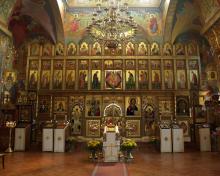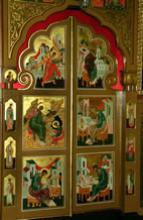 The most prominent feature of an Orthodox church is the Iconostasis, consisting of one or more rows of Icons and broken by a set of doors in the center (the Holy or Royal Doors) and a door at each side (the Deacon's Doors).
The most prominent feature of an Orthodox church is the Iconostasis, consisting of one or more rows of Icons and broken by a set of doors in the center (the Holy or Royal Doors) and a door at each side (the Deacon's Doors).
A typical Iconostasis consists of one or more tiers (rows) of Icons. Ours is made up of four tiers. At the center of the first, or lowest, tier, are the Royal Doors, on which are placed Icons of the four Evangelists who announced to the world Good News.
 At either side of the Royal Doors are always placed an Icon of the Savior (to the right) and of the Most Holy Theotokos (to the left). On either side of the Royal Doors, beyond the Icons of the Lord and His Mother, are two doors—Deacon’s Doors.
At either side of the Royal Doors are always placed an Icon of the Savior (to the right) and of the Most Holy Theotokos (to the left). On either side of the Royal Doors, beyond the Icons of the Lord and His Mother, are two doors—Deacon’s Doors.
Ascending above the Local Icons are three more tiers of Icons. Immediately above the Icon of the Mystical Supper is placed an Icon of the Savior in royal garments, flanked by His Mother and John the Forerunner and an array of other saints, included the Archangels Michael and Gabriel, the Apostles Peter and Paul and bishop saints and martyrs. This tier is called the Deisis (prayer), since all in this tier are turned to Christ in supplication. The tier immediately above are Icons of the principal Feasts of the Lord and the Theotokos.
The top row contains the Old Testament Prophets, -- in the midst of which is the Birthgiver of God with the Divine Infant Who is from everlasting and Who was their hope, their consolation, and the subject of their prophecies.
At the very top of the Iconostasis is placed the Holy Cross, upon which the Lord was crucified, effecting thereby our salvation.
Iconostasis in an Orthodox church
The iconostasis represents one of the most important architectural features of Orthodox churches. It is an unbroken screen, composed of icons, separating the Sanctuary, where the sacrament of the Eucharist is celebrated, from the central part, the nave, where the congregation stands. It consists of several rows of icons placed on horizontal wooden transoms, either close to one another or separated from one another by half-columns, the result being a great number of icons enclosed in separate, and often carved, gilt or painted frames.
It is well known that the original iconostatsis in the form of a screen between the Sanctuary and the nave has existed in Christian churches from very ancient times. We find information about ancient screens in the writings of Church Fathers... The form and height of these original screens varied. ... On the inner side, that is, on the side of the Sanctuary, was a curtain which was drawn open or closed in accordance with the various stages of the church service...
The Sanctuary screen began to grow more complex very early. At first under the architrave, and later upon it, immediately over the Royal Door, was an icon of the Saviour, and later a triptych of the Saviour, the Holy Virgin and John the Baptist ... the so-called Deisis. This triptych of the Sanctuary screen, brought to Russia from Byzantium, is supposed to be the initial form, from which the Orthodox iconostasis gradually evolved on Russian soil. This evolution took the shape of adding to the above mentioned icons and of increasing the number of storeys or tiers. By the XIIIth and XIVth centuries Russia already possessed iconostases of many tiers; much later, in the XVIIth or XVIIIth centuries, this form spread from Russia to other Orthodox countries.
from The Meaning of Icons by Leonid Ouspensky and Vladimir Lossky. St. Vladimir's Seminary Press, Crestwood, New York, 1989.
